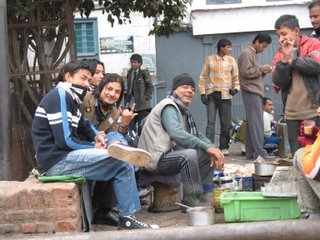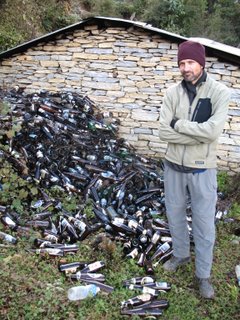Well..that took a little longer than we thought. Not to worry, though. We're both safe and sound in magical Kathmandu trying to put a few pounds back on our scrawny bodies. What we thought was going to be a nice two or three week hike turned into a month + a day of hard work and rarely interrupted bliss. Where to begin....
 Morning Departure for the TrailheadLink to current photos
Morning Departure for the TrailheadLink to current photosI'm afraid some description will be lost on those who don't like to spend time in the mountains so first, a little context. Before we even made it into Nepal, we knew we would do at least one trek. The Annapurna Circuit was one among several possibilities but we'd heard grim stories of it suffering the ruin of its own popularity. Images of backpack and Gore-tex-clad Westerners lined up at narrow passes or cable bridges kept our thoughts tentative for this route. I'd heard about Annapurna before I got my first passport over twenty years ago and, even then, the area was already a well known destination for trekkers the world over.
The word 'trek' itself is an unfamiliar word to most Americans. We typically describe the activity as 'backpacking' which is partially correct. Within the setting of North America, mountain backpacking is pretty much limited to putting everything you need to survive into a backpack and heading out into the wilderness. In mountainous places that have been inhabited for far longer, mature settlements and even societies existed long before there were roads or cars. Populations are more dense and humans live, as they have for a long time, with an intimate relationship with the mountains. Much of the Nepal is populated like this and trekking through it yields a much different kind of experience. You still get the nature but you also get a cultural component that can be just as rewarding.
Barring Tibet, Nepal has the highest average elevation of any country on earth. The majority of its land slants either up or down some part of the Himalayas and travel, even now in more places than not, has been limited to those willing to do it on foot. Necessity gave birth to a well developed network of "roads" (trails, actually) used for trade. People either carried their goods themselves or loaded them on horses, donkeys or yaks. As trips can take days or weeks, every village had at least one inn or teahouse for travelers to eat and bed down for the night.
Nepal remained closed to the rest of the world until 1950 when its king, optimistic about the prospect of earnings from foreign exchange, agreed to let in tourists. In the late 1960's, budget travelers looking for unspoiled, off-the-beaten-track destinations stumbled upon the mountain trade routes and their teahouses and inns. Word spread slowly that you could walk among the most amazing mountains on earth with the added bonus of spending time in a culture minimally affected by Western development. By the time Tami and I arrived in Nepal the reputation had had the better part of four decades to spread far and wide. As I said, we were tentative if not outright skeptical.
We started our Nepalese visit in Pokhara, the traditional jumping off point for Annapurna. Arriving directly after five months in India and, more importantly, after three weeks in Varanasi -- pressure-cooker India distilled into one, very dense and intense city -- the refined calm and cleanliness of Pokhara's tourist area only increased our suspicion about overexploitation of the area.
On our first full day we decided to get some exercise by hiking up one of the lakeside hills to a huge
stupa. It was hot and we couldn't believe how much we sweat but the views were nice. We knew the high peaks were to the north but, being the end of monsoon season, clouds shrouded that horizon all day. Then, as we started to go down, Tami stopped with an oath that most Christians would think mildly inappropriate. Above Phewa lake in front of us, above Sarangkot ridge a few miles beyond and above and much higher off the horizon than you'd think to look for land - or, as Peter Mathiessen says in the
Snow Leopard, "...so high as to seem overhead"- a break in the clouds revealed a glimpse of the snow and rock pinnacle of Machhapuchhre. From the maps I'd seen, the Annapurna summits were twenty and thirty miles to the north. Macchapucchre loomed so big and clear, it looked no more than an afternoon's walk around the nearest hills. Then and there we both reconsidered our 'ban' on Annapurna. We were still at the very beginning of trekking season and since Pokhara had almost no other tourists yet, we reasoned the Circuit might not either. Two days later we were on a bus to the trailhead at Besisahar.
Events and observations can take on unintended portent prior to challenging and unfamiliar endeavors. Our bus ride coincided with one of the final days of the Nepali festival of Dasai. On this particular day, the faithful attempt to appease the goddess Durga with a ritual slaughter of some livestock, usually goat or buffalo. All along the five hour ride we saw fleeting and distant evidence of rural carnage. As I stepped off the bus and adjusted my backpack, I walked over to a group of twenty of so locals gathered in a circle at the side of the street. Over their shoulders I could see a young buffalo stretched between a few men pulling ropes from his back legs. His front legs and head were tied to some protruding re-bar stretching him prone to the pavement. In the next few seconds, a man standing beside the animal raised a large but very inadequately sized
khukri knife mounted on what looked like a broom stick and drove it down on the buffalo's spine at the neck. I was in no way prepared for this. I heard a loud crack, saw some red where the blade struck and the men heaved against the beast's frantic struggling. Horror of horrors, the little blade did little more than bounce off the bone and tear the skin. I saw instantly this would be a prolonged, gory affair. I was five paces down the street before I heard the next chop.
My vegetarian stomach was still reeling five minutes later when, down a side alley, I saw two legless, headless and bloated buffalo corpses wafting smoke to the heavens. To remove the animal's hair, a man with a rag-bound torch on a stick was smearing kerosene over the hides. It's been over twenty years since I stopped eating meat and the smell of barbecues holds no nostalgia for me. I hurried faster toward the trailhead.
Did I think we were marching off to our own slaughter? Not at all. After India and Varanasi, the sacrifices of Dasai were really not
so shocking. If anything, they helped to make me acutely aware of my present existence; more overwhelming than coffee and certainly more bracing than anything I'd imbibed over an adult lifetime, I was embarking on a long awaited trek, alert and appreciative of all that lay ahead.






